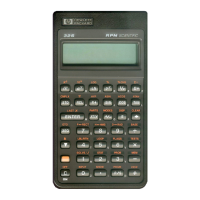Arithmetic
in
Bases
2,
8,
and
16
You can perform arithmetic operations using [±\,
Q/
00/
and (±) in
any
base.*
Arithmeticin bases 2, 8, and 16 is in 2's complementform
and
uses integers only:
• If a number has a fractional part, only the integer part is used for
an
arithmetic
calculation.
• The result of an operation is always an integer (any fractional por
tion
is truncated).
Whereas conversions change only the displayed number and not the
number in the X-register,
arithmetic
does
alter the number in the X-
register.
If the result of an operation cannot be represented in 36 bits, the dis
play shows
OVERFLOW
and
then the largest positive or negative
number
possible.
Examples.
Here are some examples of arithmetic in Hexadecimal,
Octal,
and
Binary modes:
Keys:
ariASE]
{hx}
12F I
ENTER
I E9A
[+]
12F16 + E9A
16
Display:
Description:
Sets
base
16;
HEX
an
nunciator
on.
FC9
Result.
*The only function keys that are actually deactivated outside of Decimal mode are \W\ ,
dD'
I
t-N
|,
fPH,
11/x|, |
2+1.
However,
you should
realize
that most
operations
other than
arithmetic will not produce meaningful results since the fractional parts of numbers are
truncated.
146
10:
Base
Conversions
and
Arithmetic

